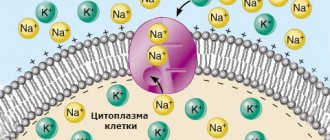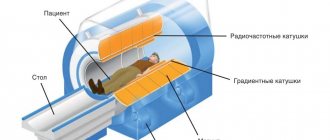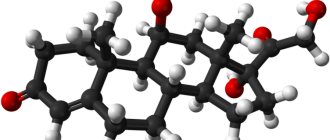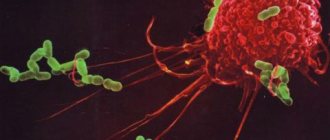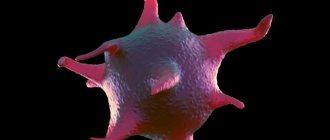This page describes calcium deficiency in adults and children. You will find everything you need to know: causes, symptoms, diagnosis, prevention and treatment of this problem. Read how to check the level of calcium in the body and how to compensate for its deficiency. Understand how the symptoms of calcium deficiency differ in men and women, adults and children. Learn the main reasons why calcium may not be absorbed. Here are 7 questions that readers often ask and detailed answers to them.
Calcium deficiency: detailed article
To correct calcium deficiency, adults and children usually take one of four substances—calcium carbonate, chloride, gluconate, or calcium citrate. The Centr-Zdorovja.Com website is not associated with manufacturers of drugs and dietary supplements. Therefore, objective information is presented here on how different drugs differ from each other. Calcium tablets can have serious side effects in adults. Below is what they are. Eat foods rich in calcium to avoid taking pills or take them as little as possible.
The role of calcium in the human body
Calcium is one of the few elements that is used by every cell of human tissues and organs. According to statistics, most of the population does not receive the required amount from food, so you need to know what role Ca plays in the body.
- Normal Ca activates the blood clotting factor, which ensures the permeability of cell membranes for their nutrition.
- Supports the functioning of the cardiovascular system by contracting the heart muscles and regulating the rhythm.
- Participates in neuromuscular conduction.
- Normalizes metabolism.
- It prevents colon polyps and cancer.
- Prevention of allergic manifestations.
- A decrease in concentration forces the body to take the necessary nutrient from the depot - bones, enamel. Result: dental pathologies, various types of microcracks, and fractures form.
- Controls normal intestinal motility, preventing constipation.
- Regulates the production of parathyroid hormones (calcitonin).
- Improves sleep.
Compensation reduces the hardness of bone tissue, leading to the development of diseases such as osteoporosis, especially in women.
The human body is a very sensitive organized structure. Lack or failure to assimilate at least one component for exchange can lead to an imbalance in many systems. Therefore, an important role in the formation of Ca deficiency is played by a decrease in the intake of magnesium, phosphorus, vitamin D, and vitamin K2, which are actively involved in the absorption of the macronutrient.
Why is calcium important?
It is essential for building strong bones. This is the primary structural component of the skeleton, in addition, the nutrient is distributed in soft tissues. It is involved in the neuromuscular, enzymatic, hormonal and metabolic functions of the body. Detailed information about the beneficial properties of the nutrient can be found in the article “The benefits of calcium for the body.” Deficiency symptoms can involve any of these functions and manifest in a variety of ways.
The table below provides information on the recommended calcium intake for different age groups.
Calcium absorption depends on:
- the body's needs for it;
- food eaten;
- nutrient content in food.
You can get enough calcium by eating a variety of foods high in the mineral:
- dairy products;
- greenery;
- leafy vegetables;
- seafood;
- nuts.
There are fortified products where additional calcium is added:
- Orange juice;
- breakfast cereals;
- bread, etc.
Lack of calcium in the body: causes of deficiency
- The absorption of Ca directly depends on the norm of magnesium and vitamin K2 (MK7). These two important elements are closely interrelated. With their deficiency, Ca does not go to the right places, but has only two paths. The first one is washed out in large quantities with the kidneys, including from the bones, the second one is deposited in the muscles - these are cramps, in organs - calcification, in blood vessels - arrhythmia, in joints - arthritis.
- An insufficient amount of Ca in the body can be associated not only with a limitation of its intake from food, but also serve as a signal of vitamin D hypovitaminosis.
- In women, a decrease in calcium in the blood is observed during menopause. A change in estrogen production affects the lack of nutrient retention in bone tissue. The less female sex hormones there are, the more substance is lost.
- Another factor in the decrease is older age. The older we get, the more difficult it is for our body to absorb calcium from food, so after 50 years of age it is recommended to take dietary supplements K2 (MK7) or learn to prepare the enzymatic dish natto, which contains a lot of K2 (MK7).
- An unbalanced diet plays an important role in the absorption of nutrients; this phenomenon is also called malabsorption (malabsorption). Consumption of large amounts of sugars together with a macronutrient leads to poor absorption due to the formation of an insoluble compound. Conversely, consuming low-fat dairy products reduces the body’s ability to absorb calcium from food.
Important: Not only simple sugars affect the speed and quality of absorption. Excessive consumption of foods rich in alkaline acid (spinach, chocolate, soy, almonds) also leads to the formation of insoluble calcium salts. Drinking alcohol and coffee (more than 3 cups) can increase the leaching of the element along with urine and feces.
- A sedentary lifestyle does not retain the nutrient, which is a common cause of calcium deficiency in the body and the manifestation of symptoms.
Causes of calcium deficiency
Why is calcium not absorbed? A condition in which there is not enough Ca is called hypocalcemia. The reason is a disruption in the production of hormones in the parathyroid glands. Occurs due to damage or removal of organs, cancer, insufficient hematopoiesis. Some people have a genetic predisposition to the disease that is passed on from generation to generation. Often, a deficiency of an element occurs due to insufficient exposure to the sun or minimal intake from food.
Ca deficiency diseases
Let's consider diseases and functional disorders that lead to hypocalcemia (low calcium levels in the blood plasma).
- Renal failure - with pathology, there is an increased excretion of the element in the urine.
- Hypoparathyroidism is insufficient functioning of the parathyroid glands, the hormones of which are responsible for the absorption of calcium and its metabolism.
- Taking medications – Many medications can affect calcium levels. Such substances include antibiotics, diuretics, steroid hormones, and chemotherapy drugs for cancer.
- Inflammation of the gastrointestinal tract - disturbances in the functioning of the digestive organs lead to functional disorders in the digestion and absorption of food, which can lead to hypocalcemia.
People with lactose intolerance, strict vegetarians, teenagers during a period of active growth, pregnant women, women with painful and heavy periods, and women in menopause are at increased risk of developing calcium deficiency. These groups need special control; they require increased consumption of not only foods rich in the element.
General symptoms
Calcium deficiency is expressed in the following symptoms:
- Cramps. The occurrence of cramps in the calves at night or in the morning. Less commonly, contractions can be observed in the thighs, arms and armpits.
- Dry skin and the development of chronic itching; psoriatic changes are also one of the manifestations of deficiency.
- Brittle nails.
- Increased fatigue and feeling of chronic fatigue.
- Damage to the enamel - teeth begin to decay, multiple caries appear due to thinning of the enamel. By the way, significant darkening can also be a symptom of deficiency.
- Fractures – weakening of bone tissue provokes an increase in injuries.
- Sleep disturbance – research has found that blood calcium levels are directly related to the deep sleep phase. This phenomenon is possibly due to its participation in the synthesis of the hormone tryptophan (which is responsible for proper rest).
Also, reduced nutrient intake can cause a plateau effect when losing weight or a decrease in the effectiveness of weight loss. Calcium, which is found in adipose tissue, helps regulate metabolism and is also responsible for the removal of fat (in fact, fat cells with a high mineral content are most effectively broken down). That is why, when following a diet, it is necessary to consume foods with a high nutrient content in sufficient quantities.
Paresthesia often occurs - a feeling of “pins and needles”, tingling, burning or numbness. There may be an imbalance in the entire activity of the central nervous system with the appearance of tremor, memory impairment, and confusion.
Symptoms
No symptoms can accurately establish that an adult or child does not have enough calcium in the body. Popular medical websites list the following signs: fatigue, bad mood, chest pain, heart rhythm disturbances, hoarse voice, difficulty swallowing, dry skin, brittle hair and nails, tingling or, conversely, loss of sensation in the arms and legs, psoriasis, cataracts. This is all quackery. The symptoms listed above are most likely caused by something other than calcium deficiency. Leg cramps almost certainly indicate a lack of magnesium in the body. Magnesium-B6 tablets are highly likely to help with them. And if you take calcium supplements without magnesium, the cramps are unlikely to go away. Perhaps the only reliable symptom of calcium deficiency is decreased height in an adult.
What does calcium deficiency lead to in the body?
Calcium deficiency in the body increases the risk of dental problems in children and adults. Perhaps, due to impaired skeletal development, the child will grow weak and frail. It is possible that calcium deficiency in adults increases the risk of bone softening and fractures. However, in the 2000s, the results of large-scale studies were published showing that taking calcium supplements daily for many years did not prevent adults from breaking the hip and other bones. Perhaps a lack of calcium aggravates high blood pressure and cardiovascular diseases. But this is a dubious hypothesis. Almost no symptoms allow us to say for sure that a child or adult does not have enough calcium in the body.
- Calcium preparation 200 mg from Bayer - also contains 250 IU of vitamin D3
- Calcium citrate 315 mg from 21st Century - also contains 250 IU of vitamin D3
- Calcium Carbonate 600 mg Chewable Tablets - Also contains 400 IU Vitamin D3
What are the symptoms of calcium deficiency in women?
It is possible that calcium deficiency in the body increases premenstrual symptoms in women. But this has not been proven. It is unlikely that taking supplements of this mineral will relieve PMS. Start taking magnesium B6 at a dosage of 6 mg per 1 kg of body weight 3 weeks in advance - and you will experience PMS much easier in the next cycle. Once you are convinced that magnesium is helping, continue to take it every day without interruption. L-glutamine also helps with PMS almost instantly if you take 3-5 grams of it in capsules or powder dissolved in water. Women who are overweight and consume a lot of sweets should also take chromium picolinate.
Watch the video - an excerpt from the popular TV show “About the Most Important Thing.” A nutritionist talks about the importance of calcium for women. Find out which popular foods flush this mineral out of your body.
Lack of calcium in the body symptoms in women
The body of the fair half of humanity is protected by nature from the loss of calcium with the help of estrogens. They help preserve it in bones and enamel, so hormonal changes directly affect the development of deficiency.
During pregnancy, a woman has to consume calcium not only for the needs of her own body, but also to supply the baby for normal growth and development. Moreover, nature is quite cunning - if the nutrient is not enough, then it will use all its strength to preserve the fetus, actively taking reserves of the substance from the bones and teeth. This is why expectant mothers’ teeth quickly decay during pregnancy.
The signs of hypocalcemia in women are practically no different from those in men. The only difference is the change in the flow of menstruation. The phenomena of PMS intensify - increased pain during menstruation, cycle disruption (if women have not had any problems before).
Fact: not only calcium supplements, but also the introduction of magnesium and vitamin B6 supplements into the diet will help ease the course of PMS (premenstrual syndrome). These supplements will greatly reduce the dose of non-steroidal drugs.
About the symptoms of calcium deficiency in a child
Calcium deficiency in children can manifest itself:
- retardation of the child in growth and mental development;
- violation of dental development;
- constant fatigue;
- drowsiness;
- lethargy;
- heart rhythm disturbances;
- instability of blood pressure with a tendency to arterial hypertension;
- disorders of sexual development;
- brittle bones and frequent fractures;
- poor healing of bones after fractures;
- increased bleeding;
- increased sweating;
- emotional instability;
- decreased performance at school;
- poor ability to absorb new information;
- easy bruising.
How to determine calcium deficiency
Blood must contain a certain amount of the element. Symptoms may not always be associated specifically with calcium deficiency. To accurately determine your needs, it is enough to take a simple biochemical blood test with setting the concentration. This method is effective, but only indicates a deficiency of a macronutrient, while its causes are important to establish in order to fully eliminate hypocalcemia.
Sometimes, an analysis can be prescribed to determine Ca ions, somewhere from 1 to 1.5 mmol/l, but it is less accurate and more expensive (it is preferable to choose the simplest option).
The norm of Ca in the blood is approximately 2.2 to 2.8 mmol/l, this is only 1 percent out of 100, the bulk is stored in bones and tooth enamel.
On the eve of the test, it is recommended not to overeat, take alcohol, medications that increase Ca, take droppers with a large amount of solutions, and refrain from cigarettes and physical activity for 30 minutes before the test. Otherwise the result will not be correct. If the test is low, do not panic, but wait for additional tests:
- urine;
- phosphorus content (without it, Ca metabolism is disrupted, they are inseparable);
- magnesium and vitamin D;
- production of the level of parathyroid hormone of the parathyroid gland, its increase reduces the concentration of the element;
- do densitometry to determine the state of bone density.
Based on the diagnosis, the doctor will determine why the nutrient is lacking. For example, sufficient content is supplied with food, and in the urine its increased level or blood plasma gives a normal Ca result, and densitometry shows sparse bones. There are many reasons, the specialist will find the main one and prescribe treatment.
Why does “calcium hunger” occur in the body?
If we determine the common causes of calcium starvation, then there are only two of them:
- Low levels of macronutrients in food;
- Reduced absorption of calcium by the body.
The first reason is clear: to replenish an element, you need to consume more products containing this element. Let's take a closer look at the second reason. Why does the body refuse to absorb calcium? After all, the body needs this chemical element.
The problem lies in our diet, which creates an acid-base balance. Excessive consumption of protein products (sausages, smoked meats and other delicacies) leads to acidification of the body. Calcium, having basic, or alkaline properties, neutralizes unnecessary acids, forming insoluble salts. But such calcium turns out to be bound and does not participate in the life of the body. Some of the insoluble salts are excreted from the body, and some are deposited in organs and cells in the form of lime deposits, forming sand and stones, and in blood vessels - blood clots and blood clots.
The effect of vitamin D on calcium balance
Vitamin D is a group of biologically active substances. The main ones in it are cholecalciferol (D3) and ergocalciferol (D2), which ensure the absorption of calcium and phosphorus in the small intestine. Thus, a deficiency of vitamin D in the body causes a deficiency of calcium. Cholecalciferol is synthesized under the influence of ultraviolet (sun) rays, therefore, in the summer you should not miss the opportunity to be in nature, bask in the sun and sunbathe a little (without fanaticism). Ergocalciferol is found in eggs, sea fish, and cream. Thus, by drinking a glass of unskimmed milk, a person receives both calcium and vitamin D, which promotes the absorption of the metal.
Effect of magnesium on calcium
Magnesium and calcium are considered antagonists, however, magnesium interacts with calcium to regulate blood vessel tone and participate in muscle contraction. Calcium affects the contraction of smooth muscles, magnesium, on the contrary, relaxes muscles and dilates blood vessels. Magnesium affects hormones that control calcium metabolism and the absorption of macronutrients by the body. An optimal diet should contain calcium and magnesium in a 2:1 ratio. Magnesium also maintains the electrolytic potential of intercellular membranes and promotes the penetration of calcium, sodium and potassium ions through them.
Read more about magnesium in the articles Magnesium norm in a blood test: indications for analysis, causes of magnesium deficiency and Lack of magnesium in the female body: symptoms, causes, treatment.
Features of hypocalcemia in children and adolescents
A young body requires an increased intake of Ca. This is due to active growth, development of the neuromuscular system, and increased physical activity. The teenage period recommends daily dosages significantly higher than the dosages of adults, since this age gives a sharp jump in development and hormonal changes.
An important influence on macronutrient deficiency is also exerted by poor nutrition, which in many children, without parental control, turns into the endless consumption of “junk food” - fast food, sweet carbonated drinks, etc. Such food is rich only in fats and simple carbohydrates, with a meager content of vitamins and minerals .
How much element should children consume by age?
- From birth to six months when feeding only breast milk – 200 mg.
- From 6 months to a year – 260 mg.
- 1 to 3 years – 750 mg.
- From 4 to 9 years – 1000 mg (daily requirement for adults up to 50-55 years old, after -1500 mg.).
- 10 – 19 years – 1300 mg.
Symptoms of calcium deficiency in a child’s body appear quite quickly; often the first signs of deficiency are cramps in the calf muscles at night and restless sleep. Children become irritable and may experience tremors or twitching. Adolescents (especially asthenic girls) often experience fainting.
Hypocalcemia at a young age affects the functioning of the cardiovascular system, causing palpitations and slowing of the rhythm.
The most dangerous sign of mineral deficiency is rickets, which can lead to multiple irreversible skeletal deformities.
Treatment of hypocalcemia
Treatment of acute hypocalcemia is carried out only in a hospital, since this condition threatens the patient’s life.
In case of chronic calcium deficiency, the basis of therapy is calcium supplements and vitamin D. Any calcium supplements are used in such dosages that the daily intake of calcium in the body is at least 1.5–2 g. In parallel, vitamin D is prescribed, the dosage of which is selected by the doctor based on the needs patient. The effectiveness of treatment is assessed by the disappearance of symptoms of hypocalcemia and normalization of calcium levels in the blood serum according to the results of laboratory tests. Serum calcium levels at the beginning of treatment must be monitored quite often (weekly or once every 2 weeks), and after stabilization of the condition, it is enough to take a blood test once every 3 months.
What foods contain calcium
If the symptoms of hypocalcemia are in the early stages, without progressing to serious clinical diseases, then the deficiency can be successfully eliminated by introducing a list of calcium-rich foods into the diet.
The best known sources of the mineral are dairy products. Sufficient consumption of cottage cheese and cheese allows you to fill the body’s daily needs. For example, in order for an adult to get his daily requirement, it is enough to eat 160 grams of cream cheese (this is in the complete absence of Ca in other menu products). The element obtained from milk is well absorbed by the body, and such food is an excellent source of protein.
But not only “milk” can cover the body’s needs, especially since there is a significant segment of the population with lactase deficiency (intolerance to the milk sugar lactose). Many vegetarians also avoid dairy products. In this case, cabbage, spinach, and nuts are valuable sources.
List of foods rich in calcium
| Name | Amount of calcium per serving (mg) | Serving size in grams |
| Eggs | 30 | 1 PC |
| Sardines in oil | 235 | 60 |
| Beans | 130 | 200 gr. boiled |
| Chickpeas | 98 | 200 gr. boiled |
| Parsley and dill | Approximately 200 mg | 100 |
| Sea kale | 80 | 100 |
| White cabbage, cauliflower, broccoli | 130 mg | 200 |
| Spinach | 50 | 100 |
| Garlic | 180 | 100 |
| Prunes | 145 | 120 |
| Dried apricots | 65 | 120 |
| Oranges | 60 | 150 |
| Almond | 75 | 30 |
| Ice cream (made from natural cream, not vegetable fats) | 125 | 100 |
| Cottage cheese | 140 | 200 |
| Cheese | 180 | 30 |
| Milk | 240 | 200 ml |
| Yogurt | 210 | 150 ml |
As can be seen from the table, a lot of Ca is found not only in well-known dairy products. It can easily be replenished from quite affordable ordinary greens, legumes, and canned fish. Seafood, by the way, is recommended to be consumed without fail if there is a lack of calcium, as a source of vitamin D.
Up to 50 years of age, natural food is absorbed almost completely, enriching the body with the necessary mineral, but this applies to healthy people.
Folk methods for restoring calcium deficiency
You can compensate for calcium deficiency using traditional methods:
- The simplest and most effective way is that you need to increase your consumption of dairy products. This is especially useful for small children for the formation of the bone skeleton and teeth growth . Every day, eat 100 g of cottage cheese with sour cream and drink a glass of milk or yogurt. To ensure proper absorption of calcium, do not forget to take vitamin D.
- Diversify your menu with fish products and meat.
- You should not immediately resort to treatment with pills when you can do without them. They can be replaced with eggshells and lemon juice.
Effective recipe with lemon
Cooking process:
- It is necessary to wash the shell thoroughly. Then put it in a frying pan and dry it over low heat. You can also use the oven or microwave to dry.
- When the shell is dry, you will need to grind it to a powder and extinguish the contents with lemon juice. For one egg, 2 tsp is enough. lemon juice.
Drink the resulting mixture twice a day during meals. For prevention, such a course is no more than 2 months. If your blood tests show an acute calcium deficiency, you will need to extend the course over 3 months.
This recipe actually helps to compensate for calcium deficiency, since eggshells contain more than 25 micro and trace elements, zinc, silicon, fluorine, iron, selenium, and manganese. This powder can be drunk not only by adults, but also by children. It does not harm the body and eliminates diathesis.
Children drink milk
This phrase from the song of the Soviet cartoon is known even to those who have never seen it. Cow's milk does have a high calcium content, but its role is significantly overrated. After all, in order to cover the body’s expenditure on the mineral, it is necessary to consume at least 1 liter every day, and to obtain the necessary calcium for pregnant women, even more – about 2 liters.
But that's not the problem with whole milk. Pediatricians do not recommend giving it to children under one year of age due to the high likelihood of developing allergies and the high concentration of phosphorus, which the child’s body has difficulty removing, wasting calcium reserves on its utilization. As a result, the problem turns into a vicious circle.
By the way, the famous pediatrician Dr. Komarovsky, in his recommendations, suggests giving up whole milk altogether for children under 3 years of age. In order not to provoke increased leaching of the element. At an older age, the enzymatic and digestive systems are fully formed, so this product no longer carries such a high risk of calcium loss.
Recent US studies have found an increased likelihood of developing the risk of prostate and ovarian tumors. More than 10 thousand people participated in the data collection; according to statistics, the incidence of ovarian cancer in women increased by 2 times with regular consumption of at least 4 servings of whole milk. For men, the numbers are slightly lower - the number of pathologies increased by an average of 30%.
The main role in provoking tumor diseases is played by insulin-like growth factor and estrogens, which are contained in milk. At the same time, cheese and fermented milk products do not cause such changes, since the enzymatic processing of these substances is largely destroyed.
Of course, you shouldn't completely exclude milk from your diet. It is enough to combine it with other sources of calcium. Also, you should not get carried away with low-fat foods, as this will deprive yourself of important fat-soluble vitamins - A, E and D, which also have high antioxidant activity.
Daily calcium intake
Calcium deficiency is a fairly common problem; not only pregnant women and nursing mothers, but also children are at risk. To prevent consequences, pay special attention to proper nutrition and control the diet, especially in children.
Daily calcium intake for children and adults:
- in infants up to 6 months – 400 mg;
- from 6 months to 3 years – 600 mg;
- from 3 to 10 years – the norm increases by 20 mg. It turns out 800 mg;
- from 11 to 16 years – 1200 mg;
- for adults – the norm is 1200 mg.
Replenishing the body with calcium
A natural way to replenish the lack of tissue-forming mineral is by eating natural products. You can successfully compensate for the deficiency by following a reasonable diet, including foods containing the mineral, while limiting foods that remove calcium.
| Products - suppliers | Substances are antagonists |
| Milk and dairy products | Fat binds calcium |
| Fish and seafood | Carbonated drinks remove trace elements from the body |
| Eggs | Chocolate |
| Salad vegetables and greens | Acidic foods with lots of fiber |
Fat cheeses are a calcium-rich product. However, fat forms insoluble compounds with the mineral that are not absorbed by the intestines.
Abuse of carbonated drinks provokes active excretion of calcium. Substances contained in acidic foods or chocolate contribute to the leaching of the mineral.
Crushed eggshells are traditionally considered a source of calcium for the body. Lemon juice can be added to the powder obtained from well-washed and crushed shells. The mixture is taken twice a day, half a spoon.
Calcium, which enters the body with food and water, has little biological activity. To treat deficiency, doctors recommend taking special medications.
For effective absorption of calcium, vitamin preparations must contain vitamin D, phosphorus and magnesium.
Vitamin complexes contain not only the mineral itself, but also substances that help its absorption.
How is the treatment done?
Now let's look at where and how you can get calcium. There are two options here:
- Intake of food products that contain the necessary element. The richest in it are dairy products - cottage cheese, milk, sour cream, yoghurts and others. In addition, large amounts are found in fish (sardines, salmon), plant products (cabbage, celery) and eggs.
- Taking medications. As already mentioned, a lack of macronutrients in the human body leads to various diseases. To avoid problems, medications are prescribed, which are divided into three groups:
- Monopreparations are supplements that contain the substance in question, which is in the form of a salt. The composition of such products is as follows: calcium carbonate (38-40%), citrate (20-21%), lactate (12-13%), and calcium gluconate (9-10%). It also contains a number of other auxiliary elements.
- Combined. From them you can get vitamin D, calcium, and other microelements important for the body.
- Multivitamins. Such preparations contain a group of minerals and vitamins that are necessary for prevention purposes. With their help, it is possible to cover the deficit for a long time.
When choosing a drug, you should consider the following points:
- Symptoms in women with a lack of calcium in the body may vary, so when purchasing, you should rely on your doctor’s recommendations and research results. Similar requirements apply to children and men.
- When combined with antibiotics (anti-inflammatory, laxatives and anticonvulsants), the absorption process may deteriorate.
- Careful study of the composition is mandatory. As a rule, the exact content of the element in one tablet is indicated on the box.
- Every drug has side effects that you should be aware of. Among them are constipation, nausea, abdominal pain and others.
- It is worth considering contraindications, including urolithiasis, tuberculosis, kidney problems and others.
Among the most popular drugs it is worth highlighting:
- Calcium chloride.
- Calcium carbonate.
- Calcemin Advance.
- Marine calcium.
Prevention of low calcium
Weight normalization is the path to health
The main preventive rule against calcium deficiency in the body is maintaining proper nutrition, which will provide a sufficient amount of the substance daily, depending on the woman’s age and her condition. It is also important to give up smoking, alcohol abuse and normalize weight. Sufficient physical activity, which does not cause overwork, but allows the whole body to work fully, will also be beneficial.
If you have the slightest suspicion that calcium deficiency is occurring, you should immediately visit a doctor. It is unacceptable to leave the appearance of pathological symptoms unattended, as this can lead to extremely serious consequences.
What to do if there is a shortage
If you notice signs of a clear calcium deficiency in yourself or your child, consult your doctor. The specialist will examine your medical history and ask about your genetic predisposition to calcium deficiency and osteoporosis.
If the specialist still suspects hypocalcemia, he will send you to the laboratory to take a blood sample. If symptoms of macronutrient deficiency are observed in a child, then you will be prescribed a urine test according to Sulkovich.
Doctors usually prescribe it in the form of vitamin supplements for people who do not have enough calcium in their body. However, it must be borne in mind that they may interact poorly with some medications:
- beta blockers to lower blood pressure;
- cholesterol-lowering agents;
- containing estrogen (can increase calcium levels in the blood).
Food assistance
You can replenish calcium reserves by consuming high-protein foods: meat, fish, legumes, cottage cheese and fermented milk components. Also look for sesame seeds, turnips and greens, broccoli and cabbage.
This is very important, because if you suffer from a lack of calcium in the body, then taking vitamins and supplements with this substance will not have much effect. It is known that it is the protein that transports substances coming from outside to their destination through special channels - into cells. This is why calcium deficiency, the symptoms of which we have already discussed, often occurs in vegetarians and people with intolerance to cow's milk protein.
What foods should you avoid?
If calcium is poorly absorbed in your body, then in addition to treatment, you need to monitor your diet. A number of food products leach Ca:
- carbonated and alcoholic drinks;
- coffee and other foods high in caffeine;
- salty dishes.
It is recommended to avoid excessive consumption of fats. They bind calcium and prevent the macroelement from breaking through to the cells. And, of course, with such a disappointing diagnosis, you should get rid of excess weight.
Disadvantage in men
Symptoms of macronutrient deficiency in the body of the stronger sex are similar to those in women. And although it is believed that osteoporosis is 4 times more common among women, men are also prone to developing it.
However, few people know that symptoms of calcium deficiency can include:
- increased irritability (this phenomenon not only prevents one from living normally, but also reduces libido);
- sleep disorder;
- severe attacks of headache.
In general, the signs of calcium deficiency in the body in men are identical to the symptoms of hypocalcemia in women.
Treatment
To treat calcium deficiency, complex therapy is used - nutritional correction and medication. It’s worth starting with a full medical examination and determining the level of the mineral in the blood. This will allow us to determine the degree of deficiency and select the optimal treatment. Self-medication can lead to negative consequences, because excess calcium is just as dangerous as its deficiency.
If there is a lack of calcium, the doctor prescribes medications containing this mineral: Calcium gluconate, Calcium D3 Nycomed and others.
To eliminate hypocalcemia, include foods rich in the mineral in your diet: milk and fermented milk (cottage cheese, yogurt, milk, cheese), leafy greens, legumes, vegetables (broccoli, cabbage), nuts, seeds, sesame. Drink mineral water, for example Borjomi.
During the diet, exclude alcohol, coffee, sweet carbonated drinks, and vegetables containing phytic acid from your diet. Such foods interfere with the absorption of calcium.
Drug treatment is prescribed by a doctor. He selects the optimal dosage and duration of therapy, taking into account the degree of deficiency, age and other individual characteristics of the patient. The doctor prescribes calcium supplements (Calcium gluconate), combination products (Calcium D3 Nycomed) and vitamin-mineral complexes (Nutrimax).
Calcium preparations
Pharmacological enterprises offer vitamin complexes containing calcium in tablets, in the form of soft chewable lozenges or lozenges. The flavored chewable tablet is especially convenient for maintaining calcium balance in children.
Calcium supplements must contain vitamin D.
Optimal proportions - for 500 mg of calcium there should be at least 200 IU of vitamin D3 or cholecalciferol.
- Calcemin
contains calcium carbonate, calcium citrate and vitamin D. Small children need to take one tablet. Older children and adults - 2 each. - Calcium D3 Nycomed
is available in the form of chewable lozenges. The maximum dose for adults is 3 tablets per day. - Vitrum Calcium+Vitamin D3
contains calcium carbonate obtained from oyster shells. Cholecalciferol ensures complete absorption of the mineral. The dose for the treatment of calcium deficiency is prescribed by the doctor. - Complivit Calcium D3
with the active component calcium carbonate and cholecalciferol has a pleasant fruity taste and smell. The drug may cause side effects in the form of gastrointestinal disorders. - Calcepan
in the form of a coated dragee is enriched with herbal extracts. The drug is taken in courses of 28-36 days.
The disadvantage of all vitamin complexes is that the microelement content is too low, which does not provide the daily intake.
Neonatal hypocalcemia
This condition is diagnosed in newborns shortly after birth. As a rule, calcium deficiency is detected in the first few days of life. However, the problem may appear after 3 or more days.
Risk factors leading to the disease are: premature birth, diabetes in the mother. In older age, the problem may arise from drinking cow's milk. Pediatricians do not recommend introducing this product into a child’s diet until 8-12 months of age.
Symptoms of neonatal hypocalcemia (age of children from birth to 7 days) are as follows:
- decreased blood pressure;
- tachycardia;
- rapid breathing;
- high risk of apnea (sudden stoppage of breathing);
- anxiety, nervousness;
- poor appetite, breast refusal;
- convulsive syndrome.
Signs of hypocalcemia in infants are:
- excessive sweating while eating and sleeping;
- rolling out of hair on the back of the head (with a lack of macronutrients, the baby rubs his head on the pillow);
- timidity and flinching at sharp and loud sounds;
- trembling of the chin while crying;
- dry skin;
- poor appetite;
- cramps and muscle spasms;
- deterioration of sleep.
Clinical symptoms of hypocalcemia in infants include:
- excessive sweating while eating and sleeping;
- rolling out of hair on the back of the head (with a lack of macronutrients, the baby rubs his head on the pillow);
- timidity and flinching at sharp and loud sounds;
- trembling of the chin while crying.
To find out if a child has a calcium deficiency in the body, there are several simple methods:
- With the tip of your finger, lightly tap the baby's cheek (in the area of the corner of the mouth). If twitching occurs, there may be a calcium deficiency.
- Squeeze the child's hand in the middle third of the shoulder. If at the same time his fingers cramp, the likelihood of a deficiency is very high.
At the first symptoms, consult a doctor. After all, a deficiency of this macroelement in a child’s body often becomes the cause of rickets. This disease can lead to disability, physical and mental retardation.
Calcium deficiency in children can occur during the formation and development of spinal curves and walking. In this case, there is a violation of posture and curvature of the bones of the limbs, and children often have low body weight. As the child grows up, hypocalcemia leads to splitting and brittle nails, cracks in the corners of the mouth, anemia and cramps.
To treat calcium deficiency, infants receive calcium gluconate intravenously and oral medications. For rickets, taking medications must be combined with the use of vitamin D by children. However, only a doctor should prescribe the dosage.




